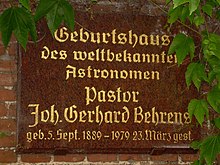Johann Gerhard Behrens
Johann Gerhard Behrens (born September 5, 1889 in Esens , † March 23, 1979 in Warsingsfehn ) was a German Evangelical Lutheran pastor and astronomer .
youth
After attending the community school in Esens, Behrens did his Abitur in Norden in 1909 and studied theology , astronomy and art history in Tübingen , Berlin and Göttingen from 1909 to 1914 . In 1914 he passed his first theological exam in Göttingen. From 1915 to 1917 he was a soldier on the Western Front , where he was awarded the Iron Cross, 2nd class. After his vicariate in Warsingsfehn, Behrens was pastor in Hittfeld , Stade and Detern from 1920 .
astronomy
In Behrens, an interest in astronomy developed early on. In addition to studying theology, he attended astronomical lectures and colleges and astonished with his mathematical skills. He took part in annual astronomers' congresses and developed a particular mathematical coordinate that was widely recognized by experts. In 1933 he was accepted as the only pastor in the " Astronomical Society " and got in touch with well-known astronomers at home and abroad. A little later one of Einstein's employees tried to persuade him to emigrate to the USA to work as an astronomer and mathematician . After the war, Behrens came into contact with NASA . The focus of his scientific work had been on researching and calculating the orbits of comets , which helped in preparation for the later satellite flights of space travel. Until 1972, NASA sent him regular notifications requesting mathematical verification. The Olympia-Werke in Roffhausen approached him at this time with the request to advise them on certain tasks involving the use of computers.
Church and resistance to National Socialism
It went down in church history as the "Behrens case". As a pastor in Stade at the beginning of the National Socialist regime, he made no secret of his aversion to the regime. From the confirmation class , he was reproached for statements such as “Children, you are hounded” and “ I prefer a Christian negro to an unbelieving German ”. A complaint was filed for subversive attitudes. On September 16, 1935, he met a procession of SS men on the street , led by an SA music band that had just returned from the Nuremberg party convention . They mistreated him, hung a cardboard sign on him that read: “I am a Jewish servant”, then led him on a triumphal march through the city, accompanied by a gathering, howling crowd. In a procedure that was courageous for the judiciary at the time, the ringleaders of the act of violence were sentenced to imprisonment. As a result, a violent conflict arose among the National Socialists , which occupied the Reich Minister of Justice ( Franz Gürtner ) and his colleague Roland Freisler , the Reich Minister of the Interior ( Wilhelm Frick ), the Reichsführer of the SS Heinrich Himmler and Adolf Hitler . In the end the perpetrators went unpunished. Behrens himself got out of the matter lightly because the process had made waves abroad as well. His regional bishop , who refused to take his side, withdrew his parish office in Stade and invited him to Hanover as his personal guest , for his protection and to let grass grow over the matter. Shortly before, Behrens had found courageous words from the pulpit: "This is my job [...] not that I keep silent like a 'dumb dog', but that I open my mouth to testify to the truth". A rehabilitation of Behrens and a reinstatement in his Stade pastoral office did not take place after the war.
Late years and death
As a pastor, he has faithfully served his last church in Detern for over 20 years in difficult times and has earned a lot of affection. In retirement he moved back to his hometown Esens, where he still took over some services and also continued his astronomical studies. He died in Warsingsfehn at the age of 89. A parish hall in Stade and Detern was named after him, the house where he was born in Esens is decorated with a memorial plaque, and in 1980 the asteroid (1651) Behrens was named after him. In 2016, a bronze bust with his portrait was placed in the town hall in Stad.
literature
- JC Poggendorf: Biographical-literary concise dictionary of the exact natural sciences . Volume 7a, T. 1, Berlin 1956, p. 131.
- Gustav Ohlendorf: Pastor Behrens, pastor and astronomer , in: Friesische Blätter, supplement to General-Anzeiger 12, 1975, No. 1-3
- Hans-Jürgen Döscher, The "Behrens Case" in Stade. Documentation on the relationship between church, party and state in the Third Reich . In Stader Jahrbuch 66, 1967, pp. 103 to 144.
- Sigrid Regina Koch: Hitler's long-term church policy is illuminated in the “Behrens case” in Stade , in: Yearbook of the Society for Lower Saxony Church History 85, 1987, pp. 253-292.
Web links
- Article on pastor and astronomer Johann Gerhard Behrens on website esens-museen.de
- Entry in the Biographical Lexicon for East Frisia (PDF file; 73 kB)
- Publications by JG Behrens in the Astrophysics Data System
swell
- Article "Johann Gerhard Behrens" by Anneus Buisman in Biographisches Lexikon für Ostfriesland , editor: Ostfriesische Landschaft.
- Report by Pastor Behrens to the district president in Stade "about the events on Monday, September 16, 1935". In: Helmut Heiber (ed.): The normal madness under the swastika . 4th edition (1st edition 1996), Herbig Vlg. 2005, p. 38 f.
Individual evidence
- ↑ Fabian Schindler: “ The difficult path of Pastor Behrens ”, in: Hamburger Abendblatt , September 15, 2010. Accessed on September 15, 2010.
| personal data | |
|---|---|
| SURNAME | Behrens, Johann Gerhard |
| BRIEF DESCRIPTION | German Evangelical Lutheran pastor and astronomer |
| DATE OF BIRTH | September 5, 1889 |
| PLACE OF BIRTH | Esens |
| DATE OF DEATH | March 23, 1979 |
| Place of death | Warsingsfehn |
